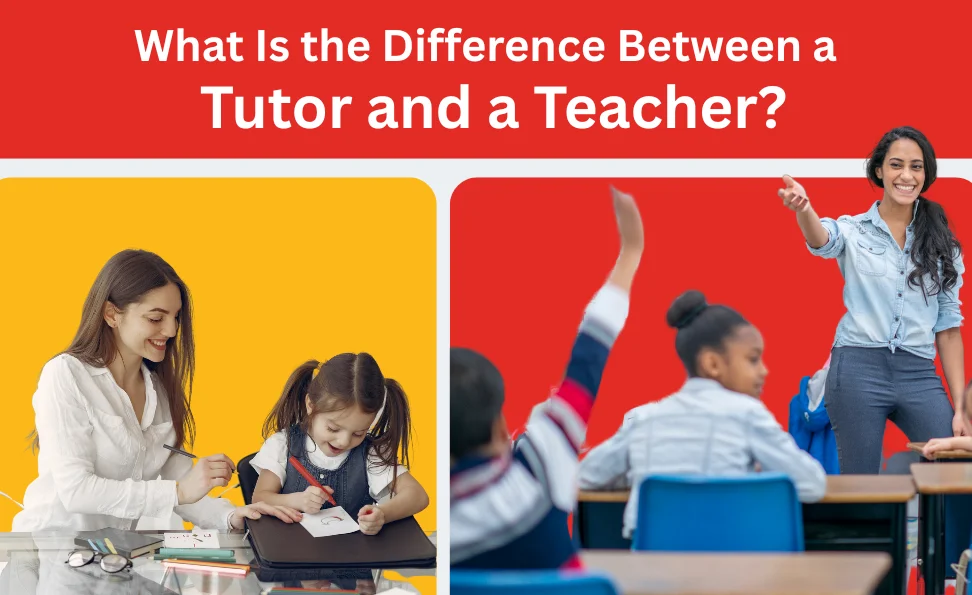What Is the Difference Between a Tutor and a Teacher?
When it comes to education, we often hear the terms "tutor" and "teacher," but many people aren't sure what exactly sets them apart. While both roles help students learn, their functions and the ways they interact with students are quite different.
Understanding the difference between a tutor and a teacher is important for parents and students to make the best educational choices.
This article will explain the differences between tutor and teachers and show you how both contribute to learning.
What Does a Teacher Do?
A teacher is typically someone who works in a school or formal educational setting. Teachers are responsible for planning lessons, managing classrooms, and helping students learn a wide variety of subjects. Teachers also assess students' progress, provide grades, and help with the overall development of students’ knowledge and skills.
The role of a teacher is broad and covers many students at once, usually in a classroom. They focus on providing general knowledge across different subjects. Difference between teacher and tutor is clear here because teachers work in large groups, while tutors often provide one-on-one attention.
What Does a Tutor Do?
A tutor, on the other hand, is someone who helps a student learn on a more individual basis. Tutors often work outside of the classroom in a more personal and focused environment. A private tutor can work with one student at a time or a small group, helping them with specific subjects or areas where they need extra help.
Unlike teachers, tutors don't always follow a structured curriculum. Instead, they focus on the student’s specific needs, such as improving in math, mastering reading, or preparing for exams. The private tutor meaning involves providing tailored support that helps students strengthen their weaknesses.
Key Differences Between a Teacher and a Tutor
While both roles are essential to a student’s education, there are some key differences between a teacher and a tutor. Here are the main factors that set them apart:
Classroom vs. One-on-One Learning
Teachers work with large groups of students in classrooms, where they must manage a range of different needs. In contrast, tutors work one-on-one with students, offering personalized attention that focuses on specific learning goals. This is one of the main differences between tutor and teacher.
Curriculum vs. Custom Focus
Teachers are required to follow a set curriculum prescribed by educational institutions or state standards. They teach general subjects to all students, focusing on the progression of knowledge in those subjects. Tutors, however, tailor their teaching to each student's needs. They can choose what to focus on, whether it’s preparing for a test or helping a student understand a difficult concept.
Setting and Flexibility
Teachers typically work in schools during set hours, and they are responsible for many students at once. Tutors often have more flexibility, as they can meet with students at convenient times and places. Tutors may even work in homes or tutoring centers.
Goals and Outcomes
The primary goal of a teacher is to provide comprehensive knowledge and help students meet educational standards. Tutors aim to provide additional support, helping students improve their understanding of specific subjects or skills. Whether it's exam preparation or catching up on missed lessons, a tutor’s goal is often more targeted. This clearly shows the difference between teacher and tutor.
Tutor vs Teacher: Teaching Methods
The way teachers and tutors approach teaching also differs. Teachers typically use a variety of methods to engage a group of students. They may use lectures, group discussions, hands-on activities, and assignments to teach their lessons. Their goal is to keep the class engaged and help everyone meet educational goals.
In contrast, a tutor’s teaching style is more personalized. Tutors often use techniques that work best for the individual student. For example, if a student learns best through visual aids, a tutor may use charts and diagrams. Tutors adapt to the student’s preferred learning style and ensure they grasp the material effectively. This flexibility is one of the biggest differences between learning and teaching as it relates to individual needs.
Benefits of Tutoring Over Traditional Teaching
Tutoring has many benefits that regular school sometimes doesn't offer. One big advantage is the individual attention students get from tutors. When students find certain subjects difficult, a tutor can give them personalized help. This one-on-one support helps students feel more confident and lets them work on specific problems without feeling overwhelmed by a whole classroom.
Another benefit of tutoring is its flexibility. Unlike teachers who have to follow a set schedule and curriculum, tutors can change their teaching methods and meeting times to fit each student's needs. This personalized approach makes tutoring a great option for students who might need extra help after school hours.
Can a Teacher Be a Tutor Too?
Yes, a teacher can also work as a tutor. In fact, many teachers take on tutoring roles to give students extra support. Teachers who tutor often help students who need more attention in areas like exam preparation or understanding a specific subject. The skills of a teacher can transfer to tutoring, as they are already familiar with the subject matter and have experience with different teaching methods.
When Should You Hire a Private Tutor?
There are several reasons why a student might benefit from hiring a private tutor. If a student is struggling with a specific subject or concept, a tutor can provide focused help in a way that a teacher might not be able to due to time constraints. Additionally, if a student is preparing for exams or needs to improve their grades, a tutor can offer customized support. Private tutor meaning becomes clear when looking at how tutors provide the help a student needs to succeed academically.
Difference Between Learning and Teaching: Why It Matters
Understanding the difference between learning and teaching helps us see why both roles are important. Teachers focus on teaching—they give knowledge, set goals for students, and check how well they’re doing. Tutors, on the other hand, focus more on helping students learn by making things clearer. They usually work one-on-one to help students understand difficult ideas.
Teachers and tutors each have important jobs when it comes to helping students learn. Teachers help all students learn the basic skills they need for the future. On the other hand, tutors provide extra support to students who need additional help to succeed.
Conclusion
In summary, both teachers and tutors are important for helping students learn. Teachers give lessons to a whole class, covering a wide range of subjects, while tutors provide one-on-one help to students who need a little extra assistance.
Knowing the differences between teachers and tutors can help parents and students choose what’s best for their learning needs.
Whether a teacher or a tutor is the better choice depends on what the student needs and how much support they require.






































Post a Comment